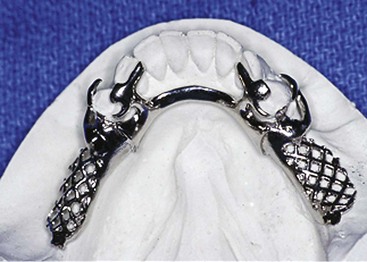CHAPTER 8 Indirect Retainers
Role of Indirect Retainers in Control of Prosthesis Movement
As was described in Chapter 4, partial denture movement can exist in three planes. Tooth-supported partial dentures effectively use teeth to control movement away from the tissues. Tooth-tissue–supported partial dentures do not have this capability because one end of the prosthesis is free to move away from the tissue. This may occur because of the effects of gravity in the maxillary arch or adhesive foods in either arch. Attention to the details of design and location of partial denture component parts in control of functional movement is the strategy used in partial denture design.
When the distal extension denture base is dislodged from its basal seat, it tends to rotate around the fulcrum lines. Theoretically, this movement away from the tissues can be resisted by activation of the direct retainer, the stabilizing components of the clasp assembly, and the rigid components of the partial denture framework, which are located on definite rests on the opposite side of the fulcrum line away from the distal extension base. These components are referred to as indirect retainers (Figures 8-1 and 8-2). Indirect retainer components should be placed as far as possible from the distal extension base, which provides the best leverage advantage against dislodgment (Figure 8-3).
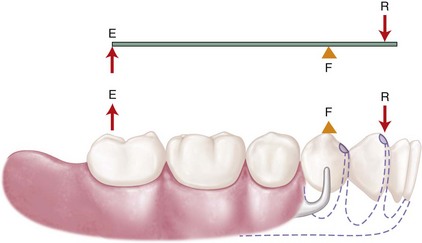
Figure 8-1 Mandibular distal extension removable partial denture showing the distal extension base being lifted from the ridge and the clasp assembly being activated and engaged, with the indirect retainer providing stabilization against dislodgment.
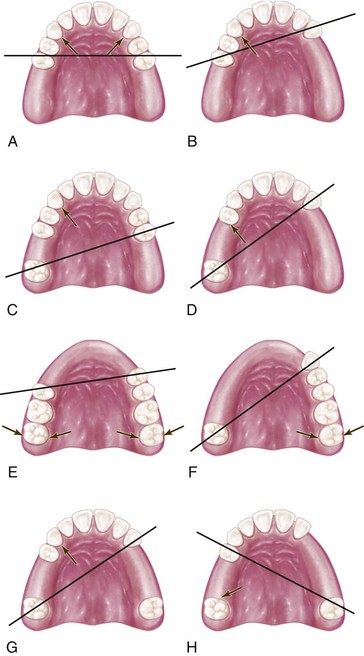
Figure 8-2 Fulcrum lines found in various types of partially edentulous arches, around which the denture may rotate when bases are subjected to forces directed toward or away from the residual ridge. Arrows indicate the most advantageous position of indirect retainer(s). A-B, In a Class I arch, the fulcrum line passes through the most posterior abutments, provided some rigid component of the framework is occlusal to the abutment’s heights of contour. C, In a Class II arch, the fulcrum line is diagonal, passing through the abutment on the distal extension side and the most posterior abutment on the opposite side. D, If the abutment tooth anterior to the modification space lies far enough removed from the fulcrum line, it may be used effectively for support of the indirect retainer. E-F, In a Class IV arch, the fulcrum line passes through two abutments adjacent to the single edentulous space. G, In a Class III arch with a posterior tooth on the right side, which has a poor prognosis and eventually will be lost, the fulcrum line is considered the same as though posterior tooth were not present. Thus its future loss may not necessitate altering the original design of the removable partial denture framework. H, In a Class III arch with nonsupporting anterior teeth, the adjacent edentulous area is considered to be the tissue-supported end, with a diagonal fulcrum line passing through the two principal abutments, as in a Class II arch.
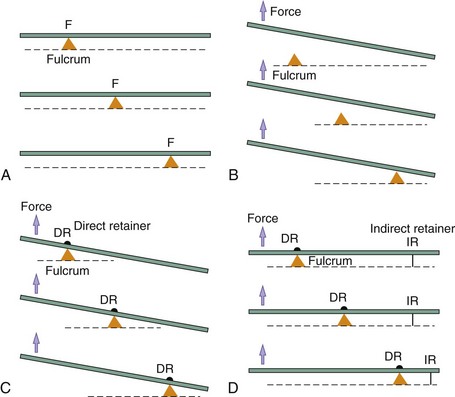
Figure 8-3 Indirect retainer principle. A, Beams are supported at various points. B, A lifting force will displace the entire beam in the absence of retainers. C, With direct retainers (dr) at the fulcrum, the lifting force will depress one end of the beam and elevate the other end. D, With both direct and indirect retainers (ir) functioning, the lifting force will not displace beam. The farther the indirect retainer is from the fulcrum, the more efficiently it should control movement.
For the sake of clarity in discussion of the location and functions of indirect retainers, fulcrum lines should be considered the axis about which the denture will rotate when the bases move away from the residual ridge.
An indirect retainer consists of one or more rests and the supporting minor connectors (Figures 8-4 and 8-5). The proximal plates, adjacent to the edentulous areas, also provide indirect retention. Although it is customary to identify the entire assembly as the indirect retainer, it should be remembered that the rest is actually the indirect retainer united to the major connector by a minor connector. This is noted to avoid interpretation of any contact with tooth inclines as part of the indirect retainer. An indirect retainer should be placed as far from the distal extension base as possible in a prepared rest seat on a tooth capable of supporting its function.
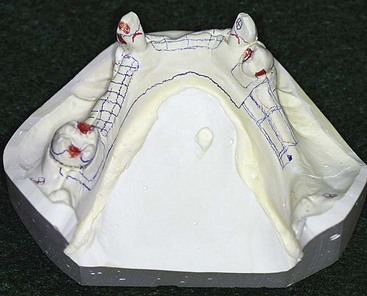
Figure 8-4 Planning the location for an indirect retainer for a Class II modification 2 removable partial denture. The greatest distance from the axis of rotation around most distal rests (fulcrum line) would fall on #22. The decision to use an incisal rest or cingulum rest will depend on the patient’s concern for the esthetic impact of an incisal rest versus having a crown (for the cingulum rest).
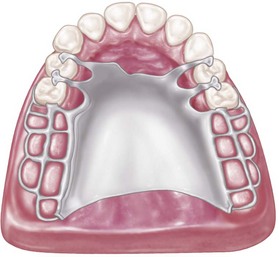
Figure 8-5 Example of indirect retention used in conjunction with a palatal plate–type major connector. Indirect retainers are proximal plates on second premolars and occlusal rests located on first premolars. A secondary function of auxiliary occlusal rest assemblies is to prevent settling of the anterior portion of the major connector and to provide stabilization against horizontal rotation.
Although the most effective location of an indirect retainer is commonly in the vicinity of an incisor tooth, that tooth may not be strong enough to support an indirect retainer and may have steep inclines that cannot be favorably altered to support a rest. In such a situation, the nearest canine tooth or the mesio-occlusal surface of the first premolar may be the best location for the indirect retention, despite the fact that it is not as far removed from the fulcrum line. Whenever possible, two indirect retainers closer to the fulcrum line are used to compensate for the compromise in distance.
Factors Influencing Effectiveness of Indirect Retainers
The following factors influence the effectiveness of an indirect retainer:
Auxiliary Functions of Indirect Retainers
In addition to effectively activating the direct retainer to prevent movement of a distal extension base away from the tissues, an indirect retainer may serve the following auxiliary functions:
These auxiliary functions derived from indirect retainers are important to consider, especially given the reported controversy as to the effectiveness of indirect retainers.
Forms of Indirect Retainers
The indirect retainer may take any one of several forms. All are effective in proportion to their support and distance from the fulcrum line.
Auxiliary Occlusal Rest
The most commonly used indirect retainer is an auxiliary occlusal rest located on an occlusal surface and as far away from the distal extension base as possible. In a mandibular Class I arch, this location is usually on the mesial marginal ridge of the first premolar on each side of the arch (see Figure 8-4). The ideal position for the indirect retainer perpendicular to the fulcrum line would be in the vicinity of the central incisors, which are too weak and have lingual surfaces that are too perpendicular to support a rest. Bilateral rests on the first premolars are quite effective, even though they are located closer to the axis of rotation.
The same principle applies to any maxillary Class I partial denture when indirect retainers are used. Bilateral rests on the mesial marginal ridge of the first premolars generally are used in preference to rests on incisor teeth (see Figure 8-5). Not only are they effective without jeopardizing the weaker single-rooted teeth, but interference with the tongue is far less when the minor connector can be placed in the embrasure between canine and premolar rather than anterior to the canine teeth.
Indirect retainers for Class II partial dentures are usually placed on the marginal ridge of the first premolar tooth on the opposite side of the arch from the distal extension base (Figure 8-6). Bilateral rests are seldom indicated except when an auxiliary occlusal rest is needed for support of the major connector, or when the prognosis for the distal abutment is poor and provision is being considered for later conversion to a Class I partial denture.
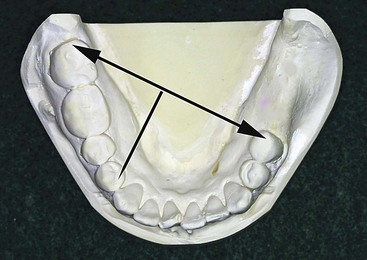
Figure 8-6 Mandibular Class II design showing a favorable location for the indirect retainer on the mesio-occlusal of the first premolar #28. This location is at 90 degrees to the fulcrum line between primary rests—DO of #20 and DO of #31—and provides efficient resistance to a denture base lift based on the longest distance to resistant rest support and because the occlusal rest is perpendicular to the load.
Canine Rests
When the mesial marginal ridge of the first premolar is too close to the fulcrum line, or when the teeth are overlapped so that the fulcrum line is not accessible, a rest on the adjacent canine tooth may be used. Such a rest may be made more effective by placing the minor connector in the embrasure anterior to the canine, either curving back onto a prepared lingual rest seat or extending to a mesioincisal rest. The same types of canine rests as those previously outlined— lingual or incisal rests—may be used (see Chapter 6).
Canine Extensions From Occlusal Rests
Occasionally, a finger extension from a premolar rest is placed on the prepared lingual slope of the adjacent canine tooth (Figure 8-7). Such an extension is used to effect indirect retention by increasing the distance of a resisting element from the fulcrum line. This method is particularly applicable when a first premolar must serve as a primary abutment. The distance anterior to the fulcrum line is only the distance between the mesio-occlusal rest and the anterior terminal of the finger extension. In this instance, although the extension rests on a prepared surface, it is used in conjunction with a terminal rest on the mesial marginal ridge of the premolar tooth. Even when they are not used as indirect retainers, canine extensions, continuous bar retainers, and linguoplates should never be used without terminal rests because of the resultant forces effective when they are placed on inclined planes alone.
Cingulum Bars (Continuous Bars) and Linguoplates
Technically, cingulum bars (continuous bars) and linguoplates are not indirect retainers because they rest on unprepared lingual inclines of anterior teeth. The indirect retainers are actually the terminal rests at either end that occur in the form of auxiliary occlusal rests or canine rests (see Chapter 5).
In Class I and Class II partial dentures, a cingulum bar or linguoplate may extend the effectiveness of the indirect retainer if it is used with a terminal rest at each end. In tooth-supported partial dentures, a cingulum bar or linguoplate is placed for other reasons but always with terminal rests (see Chapter 5).
In Class I and Class II partial dentures especially, a continuous bar retainer or the superior border of the linguoplate should never be placed above the middle third of the teeth, so that orthodontic movement during the rotation of a distal extension denture is avoided. This guideline is not so important when the six anterior teeth are in nearly a straight line, but when the arch is narrow and tapering, a cingulum bar or linguoplate on the anterior teeth extends well beyond the terminal rests, and orthodontic movement of those teeth is more likely. Although these are intended primarily to stabilize weak anterior teeth, they may have the opposite effect if not used with discretion.
Modification Areas
Occasionally, the occlusal rest on a secondary abutment in a Class II partial denture may serve as an indirect retainer. This use will depend on how far from the fulcrum line the secondary abutment is located.
The primary abutments in a Class II, modification 1 partial denture are the abutment adjacent to the distal extension base and the most distal abutment on the tooth-supported side. The fulcrum line is a diagonal axis between the two terminal abutments (Figure 8-8).

Figure 8-8 Class II, modification 1 removable partial denture framework. The fulcrum line, when the denture base is displaced toward the residual ridge, runs from the left second premolar to the right second molar. When forces tend to displace the denture away from its basal seat, the supportive element (distal occlusal rest) of the direct retainer assembly on the right first premolar serves as an indirect retainer.
The anterior abutment on the tooth-supported side is a secondary abutment, which serves to support and retain one end of the tooth-supported segment and adds horizontal stabilization to the denture. If the modification space were not present, as in an unmodified Class II arch, auxiliary occlusal rests and stabilizing components in the same position would still be essential to the design of the denture (Figure 8-9). However, the presence of a modification space conveniently provides an abutment tooth for support, stabilization, and retention.
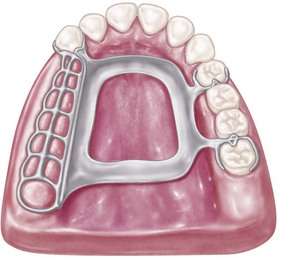
Figure 8-9 Class II maxillary removable partial denture framework design. The fulcrum line runs from the patient’s right canine to left second molar. Forces that tend to unseat the denture from its basal seat will be resisted by activation of retentive elements on canine and molar, with the use of supportive elements on the left first premolar as an indirect retainer.
If the occlusal rest on the secondary abutment lies far enough from the fulcrum line, it may serve adequately as an indirect retainer. Its dual function then is tooth support for one end of the modification area and support for an indirect retainer. The most typical example is a distal occlusal rest on a first premolar when a second premolar and the first molar are missing and the second molar serves as one of the primary abutments. The longest perpendicular to the fulcrum line falls in the vicinity of the first premolar, making the location of the indirect retainer nearly ideal.
On the other hand, if only one tooth, such as a first molar, is missing on the modification side, the occlusal rest on the second premolar abutment is too close to the fulcrum line to be effective. In such a situation, an auxiliary occlusal rest on the mesial marginal ridge of the first premolar is needed, both for indirect retention and for support for an otherwise unsupported major connector.
Support for a modification area extending anteriorly to a canine abutment is obtained by any one of the accepted canine rest forms, as previously outlined in Chapter 6. In this situation, the canine tooth provides nearly ideal indirect retention and support for the major connector as well.
Rugae Support
Some clinicians consider coverage of the rugae area of the maxillary arch as a means of indirect retention because the rugae area is firm and usually well situated to provide indirect retention for a Class I removable partial denture. Although it is true that broad coverage over the rugae area can conceivably provide some support, the facts remain that tissue support is less effective than positive tooth support, and that rugae coverage is undesirable if it can be avoided.
The use of rugae support for indirect retention is usually part of a palatal horseshoe design. Because posterior retention is usually inadequate in this situation, the requirements for indirect retention are probably greater than can be satisfied by this type of tissue support alone.
In the mandibular arch, retention from the distal extension base alone is usually inadequate to prevent lifting of the base away from the tissues. In the maxillary arch, where only anterior teeth remain, full palatal coverage is usually necessary. In fact, with any Class I maxillary removable partial denture that extends distally from the first premolar teeth, except when a maxillary torus prevents its use, palatal coverage may be used to advantage. Although complete coverage may be seen in the form of a resin base, the added retention and reduced bulk of a cast metal palate make the latter preferable (see Chapter 5). However, in the absence of full palatal coverage, an indirect retainer should be used with other designs of major palatal connectors for the Class I removable partial denture.
